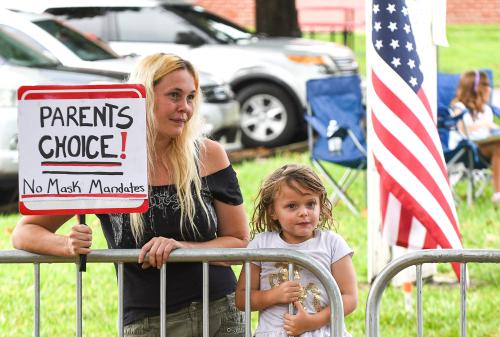Early in his term, President Joe Biden announced an ambitious “Build Back Better” legislative agenda, which included unprecedented initiatives to make high-quality child care accessible and affordable. These initiatives would have been achieved, in part, by subsidizing families’ out-of-pocket care costs while increasing care providers’ wages to address staffing shortages.
While significant infrastructure, clean energy, and innovation funding ultimately won congressional support, investments in child care did not. And now, the Republican Party’s new majority in the House of Representatives has essentially slammed the door on any new federal support for child care or relief for hard-pressed parents and child care providers.
But states—many flush with cash from pandemic relief funding—can still offer a lifeline to working families in the form of enhanced child care support.
As detailed in a recent W.E. Upjohn Institute report, State Tax Strategies to Reduce Care Costs, there are policies and practices more states can establish to support the goals of improving care access and easing care costs. Designed and implemented correctly, these policies could encourage employment and enhance earnings in this historically low-wage sector.
One smart approach for governors and state legislatures is to supplement the federal Child and Dependent Care Credit (CDCC) so their constituents get tax relief from child care expenses. On its own, the CDCC is available to working households with children younger than 13 or with a spouse or dependent living at home who is “physically or mentally incapable of self-care.” Households may claim up to $3,000 in care expenses for each of up to two qualifying individuals and receive a tax credit worth up to $1,050 per person, or about 9% of average child care spending among working households who paid for care in recent years.
But the CDCC is not available to many families who need it the most. The credit is nonrefundable, which means it can only offset income taxes owed; thus, low-income working households who owe no taxes have a critical disadvantage. Picture a one-parent household with two children and $15,000 in annual earnings; such a household has no federal income tax liability and will therefore not receive any tax benefit, regardless of how much they spend on child care. Meanwhile, a two-parent household with two children and $50,000 in annual earnings may receive up to a $1,200 tax credit each year.
The CDCC’s differential benefits to families based on income compounds existing inequities. Prior research has found that nearly one-quarter of one-parent households who work and pay for child care—disproportionately comprised of Black and Latino or Hispanic households—have incomes too low to receive benefits. Under this system, the families facing the biggest challenges in the labor market and who could financially benefit most from the tax credit are unable to receive it.
States and localities looking to lower their residents’ child care costs while encouraging employment can supplement the federal CDCC by instituting their own care credits. Twenty-two states already offer CDCCs that are a fraction of the federal credit, and some go further by offering refundable credits that allow low-income households without income tax liabilities to receive refunds. For instance, Louisiana offers a refundable child care credit to households that would have received the federal CDCC if it were refundable. The state also encourages high-quality child care by tying benefits to state-administered child care provider quality ratings; benefits increase from up to $1,050 per year for care at any provider to up to $5,250 per year at providers with the highest rating. As we found in prior research, relatively small increases in state CDCCs increase paid child care use across all household types and work among married mothers, while decreasing post-tax costs of typical caregiving services. So, there is potential for state CDCCs to have a real effect on households.
But in order for state CDCC family benefits to be fully realized, states must also take additional policy actions to address serious, post-pandemic provider shortages that limit access to care in the first place—shortages which were hoped to be ameliorated in the Build Back Better legislation. For CDCCs to fully support working families, states must also implement policies that increase providers’ notoriously low wages and allow them access to health and retirement benefits, which many lack. Only after drawing more workers into the child care sector will state CDCCs be able to expand access to care.
Given that the federal government is unlikely to muster new support for child and elder care anytime soon, state leaders need to step up to mitigate care costs, which eat up a good chunk of take-home pay, keep caregivers from working, and widen racial and social inequities. State actions could go a long way toward helping all families support their households while making sure loved ones are looked after.
Elisabeth Tobia contributed to this post.





Commentary
With federal child care legislation abandoned, it’s up to states to help working families
February 13, 2023